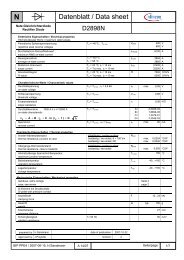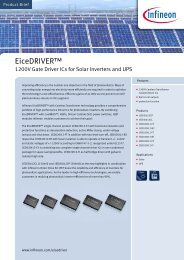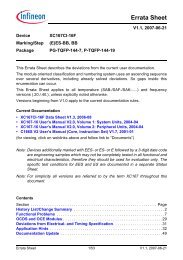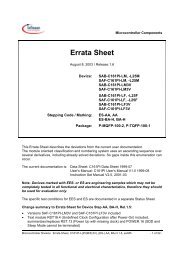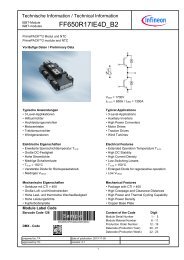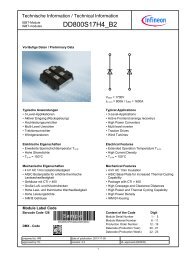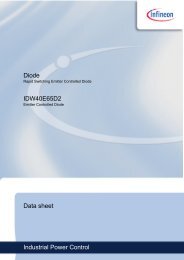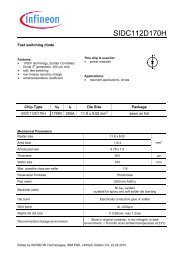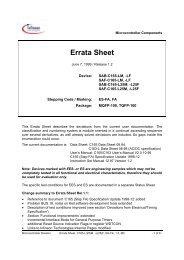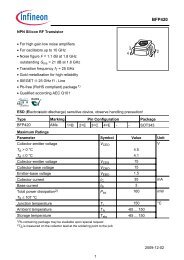Application Note CoolMOS™ CP - Infineon
Application Note CoolMOS™ CP - Infineon
Application Note CoolMOS™ CP - Infineon
Create successful ePaper yourself
Turn your PDF publications into a flip-book with our unique Google optimized e-Paper software.
CoolMOS TM <strong>CP</strong><br />
- How to make most beneficial use of the latest<br />
generation of super junction technology devices<br />
5 MOSFET Selection for the <strong>Application</strong> Based on Loss Balance<br />
Final thoughts will be offered on optimizing the SMPS performance and cost through analysis of loss balance. For<br />
any given MOSFET technology there is a figure of merit based upon the balance of resistive losses and dynamic<br />
losses.<br />
Improved MOSFET technologies will offer lower Coss related losses in proportion to Ron. If a specific application<br />
is examined with regards to the RMS conduction loss based on the variable RDS[on] and the switching loss<br />
based on dynamic factors (usually a combination of Coss pumping loss and crossover transition loss) a chip size<br />
with even balance of losses will provide the minimum total loss at the full load operating point. However, the<br />
slopes of the loss factors are not equivalent, and so considering the widest range of operating loads, the best<br />
efficiency and economics may occur working in a mode with higher conduction than switching losses at full load,<br />
especially in the case of redundant configured power supplies that normally operate at less than 1/2 of rated<br />
maximum output.<br />
The analysis problem can be approached from a few different angles. Let’s take as a starting example an<br />
interleaved two transistor forward converter (ITTF) designed for 1 kW output power, with the assumption of about<br />
90% efficiency, which will require an input power of about 1100W. The maximum output current in the switches at<br />
minimum bus voltage has been calculated using:<br />
where VIn_min is the minimum operating bulk bus voltage, POut_Max is the output power, and Dmax is the<br />
calculated maximum duty cycle (based on transformer turns ratio primary to secondary). Let’s say that as a first<br />
pass the best in class TO220 600V <strong>CP</strong> CoolMOS is chosen for consideration due to its very low RDS[on] for<br />
this package type. Then, the conduction loss can be calculated for an elevated junction temperature RDS[on] of<br />
150 mΩ from<br />
(6)<br />
This looks good, but perhaps too good? What about dynamic losses? As a first cut, the Coss pumping losses can<br />
be estimated from the energy equivalent output capacitance (CO(ER)) (integrated over 0 to 480V) in the<br />
datasheet:<br />
(7)<br />
Notice the imbalance in losses in this preliminary calculation. Switching losses can be further investigated using<br />
Eon and Eoff curves. These curves can be found in Appendix. The principle is the same, multiplying Eon and Eoff<br />
times the switching frequency, and summing the results.<br />
Another more conventional, perhaps simplistic, approach is to estimate the dynamic losses just from the<br />
crossover times (Eqn 9), which may be reasonably valid in the gate control switching region discussed earlier.<br />
(8)<br />
The picture which is clearly emerging, though, is that for a 1 kW, 130 kHz ITTF converter the 60R099 is more<br />
silicon than optimum. A detailed investigation will show that the 60R199 will offer about 15-20% lower losses, and<br />
much better economics.<br />
In Figure 21 the total conduction and capacitive losses are analyzed with RDSon being the variable function.<br />
Switching losses are not taken into account as they do not depend on RDSon. This example is built around an<br />
500W TTF (two transistor forward) stage, 130 kHz and the junction temperature for calculation purposes is<br />
105 °C.<br />
(9)<br />
17 of 32



